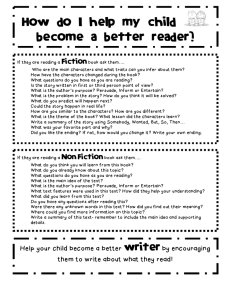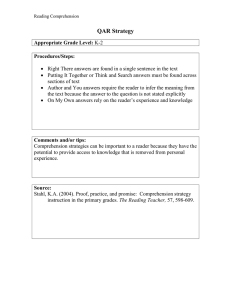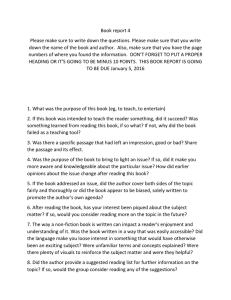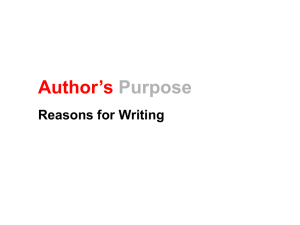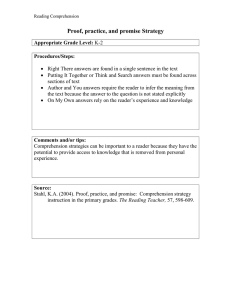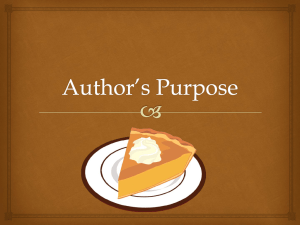1_ Sept 14 - 18
advertisement
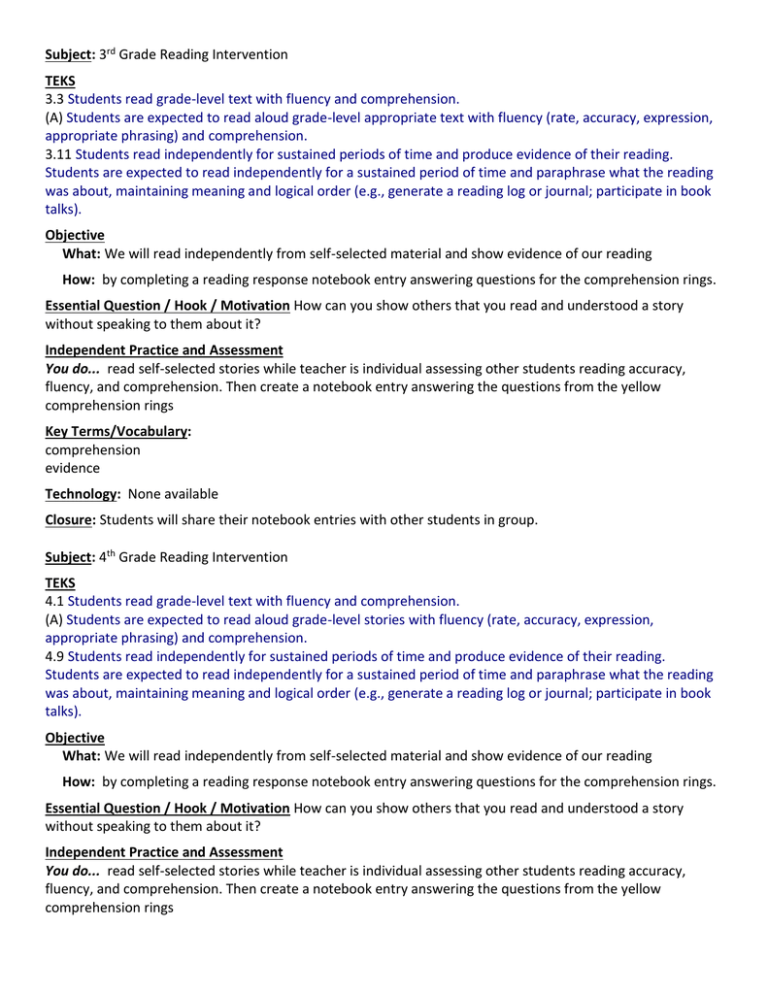
Subject: 3rd Grade Reading Intervention TEKS 3.3 Students read grade-level text with fluency and comprehension. (A) Students are expected to read aloud grade-level appropriate text with fluency (rate, accuracy, expression, appropriate phrasing) and comprehension. 3.11 Students read independently for sustained periods of time and produce evidence of their reading. Students are expected to read independently for a sustained period of time and paraphrase what the reading was about, maintaining meaning and logical order (e.g., generate a reading log or journal; participate in book talks). Objective What: We will read independently from self-selected material and show evidence of our reading How: by completing a reading response notebook entry answering questions for the comprehension rings. Essential Question / Hook / Motivation How can you show others that you read and understood a story without speaking to them about it? Independent Practice and Assessment You do... read self-selected stories while teacher is individual assessing other students reading accuracy, fluency, and comprehension. Then create a notebook entry answering the questions from the yellow comprehension rings Key Terms/Vocabulary: comprehension evidence Technology: None available Closure: Students will share their notebook entries with other students in group. Subject: 4th Grade Reading Intervention TEKS 4.1 Students read grade-level text with fluency and comprehension. (A) Students are expected to read aloud grade-level stories with fluency (rate, accuracy, expression, appropriate phrasing) and comprehension. 4.9 Students read independently for sustained periods of time and produce evidence of their reading. Students are expected to read independently for a sustained period of time and paraphrase what the reading was about, maintaining meaning and logical order (e.g., generate a reading log or journal; participate in book talks). Objective What: We will read independently from self-selected material and show evidence of our reading How: by completing a reading response notebook entry answering questions for the comprehension rings. Essential Question / Hook / Motivation How can you show others that you read and understood a story without speaking to them about it? Independent Practice and Assessment You do... read self-selected stories while teacher is individual assessing other students reading accuracy, fluency, and comprehension. Then create a notebook entry answering the questions from the yellow comprehension rings Key Terms/Vocabulary: comprehension evidence Technology: None available Closure: Students will share their notebook entries with other students in group. Subject: 5th Grade Reading Intervention (Monday, Wednesday, Friday 3x) TEKS 5.1 Students read grade-level text with fluency and comprehension. (A) Students are expected to read aloud grade-level stories with fluency (rate, accuracy, expression, appropriate phrasing) and comprehension. 5.9 Students read independently for sustained periods of time and produce evidence of their reading. Students are expected to read independently for a sustained period of time and summarize or paraphrase what the reading was about, maintaining meaning and logical order (e.g., generate a reading log or journal; participate in book talks). Objective What: We will read independently from self-selected material and show evidence of our reading How: by completing a reading response notebook entry answering questions for the comprehension rings. Essential Question / Hook / Motivation How can you show others that you read and understood a story without speaking to them about it? Independent Practice and Assessment You do... read self-selected stories while teacher is individual assessing other students reading accuracy, fluency, and comprehension. Then create a notebook entry answering the questions from the yellow comprehension rings Key Terms/Vocabulary: comprehension evidence Technology: None available Closure: Students will share their notebook entries with other students in group. Date: Monday, September 14, 2015 Subject: PLC Intervention Support 1st Grade TEKS: 1.4 Students comprehend a variety of texts drawing on useful strategies as needed. (C) establish purpose for reading selected texts 1.13 Students analyze, make inferences and draw conclusions about the author's purpose and provide evidence from the text to support their understanding. Students are expected to identify the topic and explain the author's purpose. Essential Question (Hook): Show students three different pieces of writing (picture book, dictionary, advertisement) and ask them what each of the pieces of writing are. Then ask them if we read them for the same reasons. Discuss their purposes. Instruction and Mini-Lesson I ... explain that authors have different reasons for writing books and that one reason an author will write a book is to entertain the reader. I will show students a variety of books from the classroom library which were written to entertain the reader. I will talk about the characteristics of books that show that the author is trying to entertain. I will read a selected picture book (Dog Breath The Trouble With Hally Tosis by Dav Pilkey) stopping to chart the characteristics of the book that show that the author is trying to entertain the reader. Guided Practice We ... will choose books from the classroom library that show that the author is trying to entertain the reader. Each student (or group of students) will choose one book and give two examples from the text that show that the purpose of the book is to entertain. Independent Practice and Assessment You ... answer questions: How did I identify characteristics of the text that show the author's purpose was to entertain? Students should respond that you read the text and paid attention to details in the story that were funny, silly, told a story or characteristics of fiction. Key Terms/Vocabulary Author’s purpose Entertain Technology N/A Closure Discuss how we know if the author is trying to entertain us. Review the characteristics that show the author’s purpose is to entertain: 1) The pictures are silly looking. 2) The book is fiction. 3) It tells a story. 4) It usually makes the reader laugh. 5) It does not include real information. Date: Tuesday, September 15, 2015 Subject: PLC Intervention Support 2nd Grade TEKS: 2.3 Students comprehend a variety of texts drawing on useful strategies as needed. (B) ask relevant questions, seek clarification, and locate facts and details about stories and other texts and support answers with evidence from text (C) establish purpose for reading selected texts 2.13 Students analyze, make inferences and draw conclusions about the author's purpose and provide evidence from the text to support their understanding. Students are expected to identify the topic and explain the author's purpose. Essential Question (Hook): Show students three different pieces of writing (picture book, dictionary, advertisement) and ask them what each of the pieces of writing are. Then ask them if we read them for the same reasons. Discuss their purposes. Instruction and Mini-Lesson I ... explain that authors have different reasons for writing books and that one reason an author will write a book is to entertain the reader. I will show students a variety of books from the classroom library which were written to entertain the reader. I will talk about the characteristics of books that show that the author is trying to entertain. I will read a selected picture book (Dog Breath The Trouble With Hally Tosis by Dav Pilkey) stopping to chart the characteristics of the book that show that the author is trying to entertain the reader. Guided Practice We ... will choose books from the classroom library that show that the author is trying to entertain the reader. Each student (or group of students) will choose one book and give two examples from the text that show that the purpose of the book is to entertain. Independent Practice and Assessment You ... answer questions: How did I identify characteristics of the text that show the author's purpose was to entertain? Students should respond that you read the text and paid attention to details in the story that were funny, silly, told a story or characteristics of fiction. Key Terms/Vocabulary Author’s purpose Entertain Technology N/A Closure Discuss how we know if the author is trying to entertain us. Review the characteristics that show the author’s purpose is to entertain: 1) The pictures are silly looking. 2) The book is fiction. 3) It tells a story. 4) It usually makes the reader laugh. 5) It does not include real information. Date: Wednesday, September 16, 2015 Subject: PLC Intervention Support 3rd Grade TEKS: 3.2 Students comprehend a variety of texts drawing on useful strategies as needed. (B) ask relevant questions, seek clarification, and locate facts and details about stories and other texts and support answers with evidence from text; and (C) establish purpose for reading selected texts 3.12 Students analyze, make inferences and draw conclusions about the author's purpose and provide evidence from the text to support their understanding. Students are expected to identify the topic and locate the author's stated purposes in writing the text. 3.14 Students analyze, make inferences and draw conclusions about persuasive text and provide evidence from text to support their analysis. Students are expected to identify what the author is trying to persuade the reader to think or do. Essential Question (Hook): Why does Ms. Taylor dance at the Pep Rallies on Friday? Why does Coach Madera play music when you exercise? Instruction and Mini-Lesson I ... will introduce the saying: “Author’s purpose is easy as P. I. E. – Persuade, Inform and Entertain.” Explain that authors write for one of three purposes and what each of those purposes mean. Guided Practice We ... will read three Reading Passages – "Smoking Hurts the Lungs and Heart,” “Hispanic Population Soars,” and “Casey Saves the Play.” For each passage, we will identify and chart the author’s purpose and the words, phrases, and sentences that give the reader clues about the author’s purpose. Make three column notes template on notebook paper and together record information (see Example chart for each article) Independent Practice and Assessment You ... will read a passage Be a Safe Sport!, identify the author’s purpose, and explain your choice. You will underline words and/or phrases in the passage that gave you clues about the author’s purpose. Key Terms/Vocabulary persuade – to convince the reader to agree with the author inform – to enlighten the reader about real-world topics and provide facts on those topics entertain – telling a story, describing real or imaginary characters, places and events Technology N/A Closure Read the class the following: Fast food gets bad press these days, especially since it often contains too much fat, sodium and calories, but it brings much needed convenience to our stressful busy world. Fast food is easily found and varied. At any mall, for example, customers have many choices at the food court. To avoid too much fat or salt, they can choose healthier options: salads, turkey sandwiches and so on. Fast food is also inexpensive; most menu items offer a full meal for under ten dollars. It is easy to see why fast food is so popular these days—it is convenient and reduces our stress. So don’t be afraid to enjoy a fast food meal. Ask: What is the Author’s Purpose based on the highlighted portions? The author’s purpose is to persuade the reader that fast food is okay to eat. Have students name a company that you think could have written an article similar to our example that we just went over as a class. Date: Thursday, September 17, 2015 Subject: PLC Intervention Support 4th Grade TEKS: 4.10 Students analyze, make inferences and draw conclusions about the author's purpose in cultural, historical, and contemporary contexts and provide evidence from the text to support their understanding. Students are expected to explain the difference between a stated and an implied purpose for an expository text. Essential Question (Hook): Why does Ms. Taylor dance at the Pep Rallies on Friday? Why does Coach Madera play music when you exercise? Instruction and Mini-Lesson I ... will introduce the saying: “Author’s purpose is easy as P. I. E. – Persuade, Inform and Entertain.” Explain that authors write for one of three purposes and what each of those purposes mean. Guided Practice We ... will read three Reading Passages – "Smoking Hurts the Lungs and Heart,” “Hispanic Population Soars,” and “Casey Saves the Play.” For each passage, we will identify and chart the author’s purpose and the words, phrases, and sentences that give the reader clues about the author’s purpose. Make three column notes template on notebook paper and together record information (see Example chart for each article) Independent Practice and Assessment You ... will read a passage Be a Safe Sport!, identify the author’s purpose, and explain your choice. You will underline words and/or phrases in the passage that gave you clues about the author’s purpose. Key Terms/Vocabulary persuade – to convince the reader to agree with the author inform – to enlighten the reader about real-world topics and provide facts on those topics entertain – telling a story, describing real or imaginary characters, places and events Technology N/A Closure Read the class the following: Fast food gets bad press these days, especially since it often contains too much fat, sodium and calories, but it brings much needed convenience to our stressful busy world. Fast food is easily found and varied. At any mall, for example, customers have many choices at the food court. To avoid too much fat or salt, they can choose healthier options: salads, turkey sandwiches and so on. Fast food is also inexpensive; most menu items offer a full meal for under ten dollars. It is easy to see why fast food is so popular these days—it is convenient and reduces our stress. So don’t be afraid to enjoy a fast food meal. Ask: What is the Author’s Purpose based on the highlighted portions? The author’s purpose is to persuade the reader that fast food is okay to eat. Have students name a company that you think could have written an article similar to our example that we just went over as a class. Date: Friday, September 18, 2015 Subject: PLC Intervention Support 5th Grade TEKS: 5.10 Students analyze, make inferences and draw conclusions about the author's purpose in cultural, historical, and contemporary contexts and provide evidence from the text to support their understanding. Students are expected to draw conclusions from the information presented by an author and evaluate how well the author's purpose was achieved. Essential Question (Hook): Why does Ms. Taylor dance at the Pep Rallies on Friday? Why does Coach Madera play music when you exercise? Instruction and Mini-Lesson I ... will introduce the saying: “Author’s purpose is easy as P. I. E. – Persuade, Inform and Entertain.” Explain that authors write for one of three purposes and what each of those purposes mean. Guided Practice We ... will read three Reading Passages – "Smoking Hurts the Lungs and Heart,” “Hispanic Population Soars,” and “Casey Saves the Play.” For each passage, we will identify and chart the author’s purpose and the words, phrases, and sentences that give the reader clues about the author’s purpose. Make three column notes template on notebook paper and together record information (see Example chart for each article) Independent Practice and Assessment You ... will read a passage Be a Safe Sport!, identify the author’s purpose, and explain your choice. You will underline words and/or phrases in the passage that gave you clues about the author’s purpose. Key Terms/Vocabulary persuade – to convince the reader to agree with the author inform – to enlighten the reader about real-world topics and provide facts on those topics entertain – telling a story, describing real or imaginary characters, places and events Technology N/A Closure Read the class the following: Fast food gets bad press these days, especially since it often contains too much fat, sodium and calories, but it brings much needed convenience to our stressful busy world. Fast food is easily found and varied. At any mall, for example, customers have many choices at the food court. To avoid too much fat or salt, they can choose healthier options: salads, turkey sandwiches and so on. Fast food is also inexpensive; most menu items offer a full meal for under ten dollars. It is easy to see why fast food is so popular these days—it is convenient and reduces our stress. So don’t be afraid to enjoy a fast food meal. Ask: What is the Author’s Purpose based on the highlighted portions? The author’s purpose is to persuade the reader that fast food is okay to eat. Have students name a company that you think could have written an article similar to our example that we just went over as a class.
